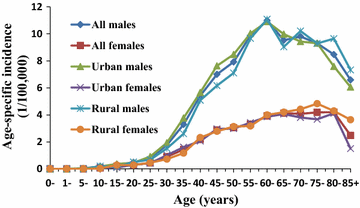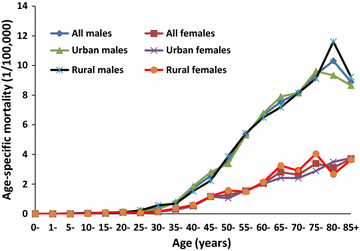Nasopharyngeal carcinoma incidence and mortality in China, 2013
- PMID: 29122009
- PMCID: PMC5679327
- DOI: 10.1186/s40880-017-0257-9
Nasopharyngeal carcinoma incidence and mortality in China, 2013
Abstract
Background: We estimated the incidence and mortality of nasopharyngeal carcinoma (NPC) in China in 2010 according to the data of 145 domestic population-based cancer registries in 2014, and no such reports since then. Hence, to further and better understand its epidemiology in China and to provide more precise scientific information for its control and prevention in China, we analyzed the NPC incidence and mortality of 255 domestic population-based cancer registries, and estimated the national rates in 2013 again.
Methods: NPC incidence and mortality data of 255 domestic cancer registries in 2013, accepted by the 2016 National Cancer Registry Annual Report, were collected and collated, and the indices of NPC such as the numbers of new cases and deaths, crude rates, age-standardized rates, and truncated rates of incidence and mortality were calculated and analyzed. The incidence and mortality in China and its constituent areas were estimated according to the national population in 2013.
Results: An estimated 42,100 new cases and 21,320 deaths were attributed to NPC in China in 2013, accounting for 1.14% of all new cancer cases and 0.96% of all cancer-related deaths that year in China. Crude incidence and mortality of NPC were 3.09/100,000 and 1.57/100,000, respectively. World age-standardized incidence and mortality were 2.17/100,000 and 1.08/100,000, respectively. The incidence and mortality of males were obviously higher than those of females and slightly higher in urban areas than in rural areas. Among seven Chinese administrative regions, NPC incidence and mortality were obviously higher in South China than in other regions and lowest in North China. Top 3 incidence and mortality provinces and registering areas all located in South China. The age-specific incidence and mortality rose quickly from age 25-29 and 35 to 39 years, respectively, peaked at different ages and varied by location.
Conclusions: These results demonstrated that NPC incidence and mortality in China in 2013 were also at high levels worldwide, which suggested that its control and prevention should be enhanced.
Keywords: China; Incidence; Mortality; Nasopharyngeal carcinoma.
Figures


Similar articles
-
Nasopharyngeal carcinoma incidence and mortality in China in 2010.Chin J Cancer. 2014 Aug;33(8):381-7. doi: 10.5732/cjc.014.10086. Chin J Cancer. 2014. PMID: 25096544 Free PMC article.
-
[Incidence and mortality of nasopharyngeal carcinoma in China, 2014].Zhonghua Zhong Liu Za Zhi. 2018 Aug 23;40(8):566-571. doi: 10.3760/cma.j.issn.0253-3766.2018.08.002. Zhonghua Zhong Liu Za Zhi. 2018. PMID: 30139025 Chinese.
-
Nasopharyngeal carcinoma incidence and mortality in China in 2009.Chin J Cancer. 2013 Aug;32(8):453-60. doi: 10.5732/cjc.013.10118. Epub 2013 Jul 18. Chin J Cancer. 2013. PMID: 23863562 Free PMC article.
-
Histopathological classification of nasopharyngeal carcinoma.Asian Pac J Cancer Prev. 2011;12(5):1141-7. Asian Pac J Cancer Prev. 2011. PMID: 21875256 Review.
-
Incidence of nasopharyngeal carcinoma in Chinese immigrants, compared with Chinese in China and South East Asia: review.J Laryngol Otol. 2009 Oct;123(10):1067-74. doi: 10.1017/S0022215109005623. Epub 2009 Jun 2. J Laryngol Otol. 2009. PMID: 19486543 Review.
Cited by
-
Predicting distant metastasis in nasopharyngeal carcinoma using gradient boosting tree model based on detailed magnetic resonance imaging reports.World J Radiol. 2024 Jun 28;16(6):203-210. doi: 10.4329/wjr.v16.i6.203. World J Radiol. 2024. PMID: 38983838 Free PMC article.
-
Subspecies Niche Specialization in the Oral Microbiome Is Associated with Nasopharyngeal Carcinoma Risk.mSystems. 2020 Jul 7;5(4):e00065-20. doi: 10.1128/mSystems.00065-20. mSystems. 2020. PMID: 32636333 Free PMC article.
-
Adjuvant Capecitabine Following Concurrent Chemoradiotherapy in Locoregionally Advanced Nasopharyngeal Carcinoma: A Randomized Clinical Trial.JAMA Oncol. 2022 Oct 13;8(12):1776-85. doi: 10.1001/jamaoncol.2022.4656. Online ahead of print. JAMA Oncol. 2022. PMID: 36227615 Free PMC article.
-
Radiomics Analysis and Correlation With Metabolic Parameters in Nasopharyngeal Carcinoma Based on PET/MR Imaging.Front Oncol. 2020 Sep 8;10:1619. doi: 10.3389/fonc.2020.01619. eCollection 2020. Front Oncol. 2020. PMID: 33014815 Free PMC article.
-
The prolonged interval between induction chemotherapy and radiotherapy is associated with poor prognosis in patients with nasopharyngeal carcinoma.Radiat Oncol. 2019 Jan 17;14(1):9. doi: 10.1186/s13014-019-1213-4. Radiat Oncol. 2019. PMID: 30654815 Free PMC article.
References
-
- Ferlay J, SoerjomataramI, Ervik M, et al. GLOBOCAN 2012 v1.0, Cancer Incidence and Mortality Worldwide: IARC CANCER BASE NO.11. Lyon: International Agency for Research on Cancer; 2013. http://globocan.iarc.fr. Accessed 18 Apr 2017.
-
- Ferlay J, Bray F, Steliarova-Foucher E, et al. (2014) Cancer Incidence in Five Continents, CI5plus. IARC Cancer Base No. 9. Lyon: International Agency for Research on Cancer, 2014. http://ci5.iarc.fr. Accessed 18 Apr 2017.
-
- World Health Organization, Department of Information, Evidence and Research, mortality database. http://www-dep.iarc.fr/WHOdb/WHOdb.htm. Accessed 18 Apr 2017.
-
- National Office for Cancer Control and Prevention, National Centre for Cancer Registration, Bureau for Disease Control and Prevention of Health Ministry. Chinese cancer mortality report-the third national death causes retrospective sampling survey. Beijing: People’s Medical Publishing House; 2010. p. 171–87 (in Chinese).
MeSH terms
LinkOut - more resources
Full Text Sources
Other Literature Sources

